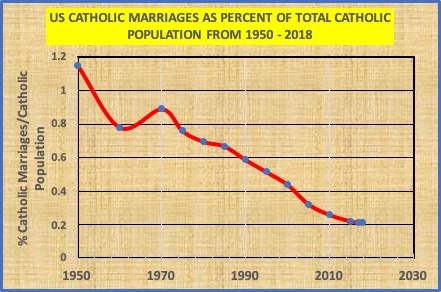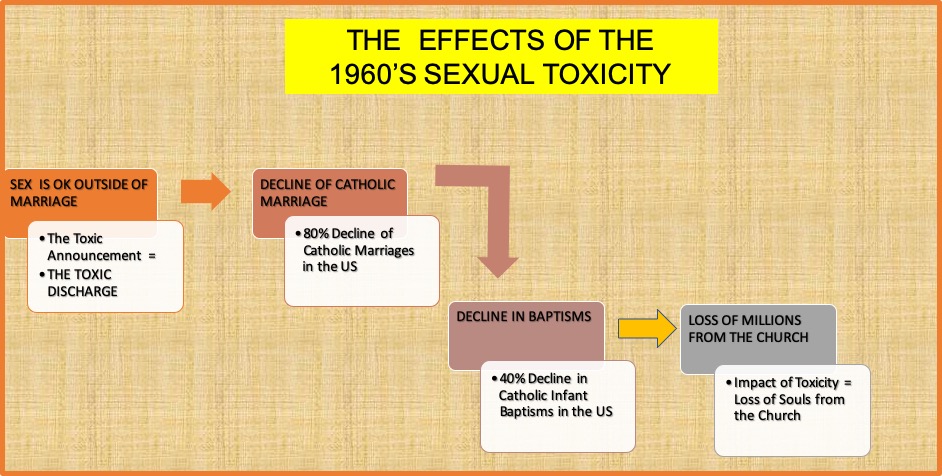OUR MINAMATA CHURCH, THE SEXUAL TOXICITY OF THE SIXTIES –WHY THE DOUBT?
(This is the original and expanded version of a paper entitled “How the Sexual Toxicity of the 1960s Has Harmed the Churchhttps://www.crisismagazine.com/2019/how-the-sexual-toxicity-of-the-1960s-harms-the-church
I have been rather astounded and amused at the controversy, indeed outright denial, surrounding Pope Emeritus Benedict’s recent essay which attributes a large portion of our current crisis in the Church to the “Sexual Revolution” of the Sixties. I react in this way simply because the evidence for the identification of the source of our “ill health” has been known for quite some time. It is a collection of empirically powerful and indisputable evidence that somehow has either been recognized and denied or has just been rather conveniently ignored at all ecclesial levels. In order to more clearly identify the multiple dimensions of the unhealthiness of our situation, let me draw a comparison to the situation of toxicity in our natural environment.
What Makes a Substance or Idea Toxic?
A substance is considered toxic when it is present over a period of time and in a place in the environment at a level that exceeds some pre-determined standard for protection. Thus, considering the aquatic environment, if a chemical is in water or in fish at a level that is above a standard that has been established to reduce the possibility of disease, the chemical is said to be at a toxic level. Immediately questions arise: how did the chemical get to this level in the water or fish? What is the source of the chemical? Where did the health standard come from? What is the source of the standard? How defensible is the standard?
So, let’s extend this to what makes something, anything, toxic? What makes an idea, a written or spoken word, a way of life, a culture, toxic? What leads to an intoxication? Toxicity appears when the effects from exposure are compared to a standard of expectation for the health, either physio-biological, psychological or morality of the given entity. If that comparison is found wanting, less than desired or otherwise unacceptable, the idea, word, life style is present at a “toxic” level.
The toxicity of something is then first revealed in some impact or effect or manifestation or behavior of a property that is initially seen as not acceptable. Some six decades ago, in Minamata Japan, some adults and children walked into the local health clinic, crippled and suffering from a most debilitating and lethal disease not seen before. The case of Minamata disease was then “discovered” and clearly was unacceptable in its effects. The link to the chemical methyl mercury was established and subsequently linked to the discharge of the chemical from a factory which was then diffused through the environment from the water to the fish to the human person. Although the effect was without doubt and clearly demonstrable in its impact, although the linkage was established between cause and effect, multiple years would pass before final and definitive corrective action was taken.
This is us! We are living in an environment that has received a highly toxic input some multiple decades ago. The toxic idea that was discharged into our environment of the Sixties was very simple: sex is healthy, freeing and fulfilling. How could anyone argue with that? If you are thinking about marriage, it would be beneficial to test out your relationship before launching into a contractual arrangement. Spend some time, maybe even a few years together. Test your sexual compatibility and then make a decision. We do have a term for this: it’s called fornication.
So, the toxic thought released into our culture was that fornication is entirely acceptable and in fact is even beneficial. Prior to this time, the moral health standard for fornication was zero. That is, fornication, sexual intercourse between a man and woman outside of marriage was not acceptable and was not in any way a function of circumstances. It was not a question of perhaps in certain situations, fornication can be recognized as helpful, maybe even necessary. Having sex outside of marriage was always taught as morally unacceptable, i.e., it was a level of toxic sex that exceeded the Church’s standard.
But what’s our problem with fornication? Why not fornicate? After all, “I need to have some outlet to my sexual desires, some way of expressing a certain sense of love. Besides, marriage is just too risky, too filled with a possible entire life of suffering and pain for me to want to chance it. Maybe later.”
Then, as a result, sexual intercourse between an unmarried man and an unmarried woman and then the further extension to sexual actions between those of the same sex, as well as adulterous relationships emerged not so much as a totally acceptable way of life but as a way that was seen as inevitable and even justifiable for the good of the couple and the individual. The increase in what is so nicely called, cohabitation (formerly, “common law marriage”, “shacking up”), in same sex relationships and in adultery have been documented in any number of reports. What was once stigmatized is now simply accepted as more or less “normal”.
This acceptability is a consequence of the inability to see any deleterious effects of “free sex”, of fornicating, of homosexual and lesbian sexual activity. Our traditional standard for determining the toxicity of moral behavior in the Church was founded on the act itself (see “On the Way to Jesus Christ”, Ratzinger, Joseph, pg 165)1. The rationale for focusing on the act rather than effects was fundamentally based on millennia of experience of the toxic effects on family and individuals. But in the Sixties, the toxic idea of healthy sex focused on immediate effects, i.e., there were no apparent ill effects from a guy and a girl having sex and in fact it was even presented as a big help to them.
The Decline of Catholic M

But where can we see the toxic effects of the Sixties? The consequences of this sexual toxicity can readily be seen today as devastatingly serious and demonstrably evident in the decline of marriage in the Church. The decline in Catholic marriage in the US from 1950 to today is more than 80%! If the health of the Church is measured at least in some sense by marriage, then our health has seriously deteriorated from this sexual toxicity, this virtual abandonment of the previous moral standard. But the response is immediate: so what’s the consequences of this decline in marriage? So what, maybe all of this is really “healthy”.
The first effect of this decline in marriage is in the sacrament of Baptism which has consequently declined some 40%. This is a most important effect of the toxic discharge since it represents the birth of new Christians. I have previously estimated (see my book “A Hemorrhaging Church” (Amazon)) the loss of Catholics from the Church, i.e., the “death” of the population that can be attributed to the toxic discharge of the Sixties. That loss over the period from 1950 to date is 10-20 million. Further, had the baptismal rate remained at 1950 levels, some additional 26 million children would have been brought to the font. These ecclesial effects of the release of a toxic message in the 1960’s are thus not minimal, not marginal, but murderously lethal to the lives of millions of souls.
The causal chain of the impact of the discharge of the toxic idea of release from sex only within marriage is simple and direct, as shown below.

We can see this causal interaction by beginning with the announcement that sex is healthy and not to be restricted to marriage. Then, fornication, that is, sex between unmarried man and woman and by extension sex between those of the same sex and adultery is presented as acceptable and even beneficial.
This toxic thinking, toxic words and ideas resulted in a most significant decline in Church Marriage followed by the accompanying effect of a decline in infant Baptisms. This reduction in “births” inevitably leads to a loss of millions of people from the practice of the faith in the Church. The toxic effect is then realized in the crippling and even “death” of multiple generations of baptized Catholics.
Then we witness a remarkable and most tragic procession. Into the hall, the clinic of the Divine love of the Father, Son and Spirit, a crippled, diseased and suffering Minamata Church has entered, desperately searching for a diagnosis and a healing. The toxicity is clear demonstrable and readily linked to the toxic source. So where is the doubt – the doubt that the sexual toxicity of the Sixties has any relevance to today’s sexual ambivalence in the Church?
It is clear that the resistance to this analysis rests on two factors: the unwillingness to identify the source of our current sexual toxicity and the unwillingness to begin to close off that source by speaking clearly of the valid standard of sexual life, i.e., zero fornication, zero same sex activity, zero adultery. How laughable it is then to implicitly speak of a different standard for fornication, a relativistic standard, a standard that depends on the uniqueness of a given situation.
For example, perhaps one can fornicate three times a week or if we were to be really conservative, only once a month. The wisdom of the Church’s moral standard becomes then immediately apparent. It is ironic, in a way, that VC II was born and lived (in the Sixties) precisely to address what had already been seen as some level of toxicity present in the Church. But the conduit of sexual toxicity continues to discharge today and only if the source is recognized and eliminated is there a hope of reducing the twisted and paralyzing realities and suffering of the people of God in today’s Minamata Church.

